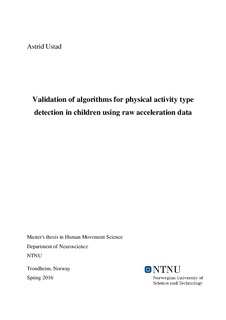| dc.description.abstract | Background: Accelerometry has become the objective method of choice to assess physical activity in children. However a number of limitations are related to how accelerometer data from children are analyzed. Valid algorithms to classify accelerometer data into physical activity types can enhance our understanding of children's physical behavior and provide useful information of different aspects of physical activity.
Aim: The aim of this study was to examine the validity of three algorithms for physical activity type detection in children using raw accelerometer data. The physical activity types of interest were the everyday activities walking, running, stair walking, cycling, standing, sitting and lying.
Methods: 15 typically developing children (7 boys and 8 girls) in the age range between 6 and 12 years conducted several repetitions of the everyday activities of interest while they wore accelerometers (Axivity AX3) on lower back and mid-thigh and were video recorded. The videos were labeled and used as gold standard for validation of the physical activity types identified by the algorithms. Three algorithms were evaluated: the Acti4 algorithm and the NTNU-adults algorithm, which were developed on data from adults, and the NTNU-children algorithm that was developed based on the children data from this study.
Results: The overall accuracy was 84.5%, 63.6% and 70.6% for the NTNU-children algorithm, the NTNU-adults algorithm and the Acti4 algorithm, respectively. The children algorithm showed consistently higher sensitivity, specificity and positive predictive values than the two adults algorithms. Sensitivity for the children algorithm was >0.89 for all activities of interest except stair walking (0.57-0.73). The NTNU-adults algorithm had very low sensitivity for walking, stair walking and cycling (<0.56) and high sensitivity for standing, sitting, lying and running (0.78-0.88). The Acti4 algorithm showed high sensitivity for walking, stair walking, running, cycling and lying (0.81-1.00), and lower sensitivity for standing (0.73) and sitting (0.66).
Conclusion: The children algorithm showed higher overall accuracy than the adults algorithms and detected the activities walking, running, cycling, standing, sitting and lying with very high precision in children. The results indicate that children-specific algorithms are necessary. This study showed that raw acceleration data from two monitors placed on lower back and mid-thigh can be used to detect and separate the static activities standing, sitting and lying, and detect the dynamic activities walking, running and cycling, with high precision in children. | nb_NO |
